What size and type nail would you use to nail an LVL together with?
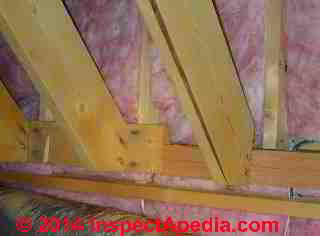 Woods Framing Toe-Nailing Connections
Woods Framing Toe-Nailing Connections
Guide to using slant-driven nails for wood framed joists, studs, sill plates, top plates, & beams
- POST a QUESTION or COMMENT near toe nailing in forest frame construction
InspectAPedia tolerates no conflicts of interest. We have no relationship with advertisers, products, or services discussed at this website.
Wood frame toe nailing: how to toe-blast joists, studs, & beams in forest framed structures.
This commodity describes the proper method for strong "double-shear" angled or toe nailing of joists or studs that barrel into beams or acme or shoe plates in wood framed buildings.
Properly done, toe-nailing makes very strong wood framing connections. But mistakes like choosing the wrong nail size, wrong nail placement, or wrong number of nails can mean weak joints and a weak construction.
Wood framing connections & connectors: this article serial explains the proper selection and installation of structural connectors, brackets & necktie plates used to connect deck or porch framing and support members.
We also provide an ARTICLE INDEX for this topic, or yous tin effort the page top or bottom SEARCH BOX every bit a quick way to observe information y'all need.
Guide for Toe Nailing Wood Framing Connections
 Definition of toe-nailing: framing nails driven on an angle from opposing sides and through the nailed-through wood framing member into the nailed-to framing member so that the "crossed" opposed toe-nails form both a shear-resistant and a withdrawal-resistant connection between the framing members.
Definition of toe-nailing: framing nails driven on an angle from opposing sides and through the nailed-through wood framing member into the nailed-to framing member so that the "crossed" opposed toe-nails form both a shear-resistant and a withdrawal-resistant connection between the framing members.
[Click to overstate any prototype]
Toe-nailing or camber-driven nails are unremarkably used where information technology is not possible to drive through the side plate or top plate into the framing member, and has been historically widely used for connecting studs to the top or lesser plate, beam to plate, and rafter to plate or ridge lath connections.
We will illustrate several of these toenail or slant-nail connections in this article.
Toe-nailing is used both stand-alone, without steel framing connectors and too toe-nailing is specified for the installation of some (not all) framing connectors.
In carpentry school we were taught that provided you employ the right blazon and size fastener (common nails, structure screws) and the correct number of them (there are tables and standards) toe-nailed from both sides of the abutment of a stringer face to the floor joist (or rafter to ridge and rafter to acme plate, or stud to top and bottom plate) the connectedness is completely adequate, and is every bit strong as that made using proper joist hanger nails and joist hangers.
Y'all will come across that there are many opportunities to brand a bad connexion using either approach, in detail, using improperly-sized, placed, or number of fasteners. There is no evidence in my feel that people make fewer mistakes using a joist hanger than using direct nailing. They just make different mistakes.
Definition of shear loading & lateral loading of wood framing connections:
Shear loads or lateral load are across the framing nails while withdrawal loads are those that tend to pull the framing nails out of the nailed-to member.
Toe-Nails Instead of Joist Hangers are OK for Framing Lumber Butt-Articulation Connections, but Don't Over-Blast and Don't Under-Nail
It is not necessary to utilize steel joist hangers if the joist is properly toe-nailed from either side into the ledger board, provided that the proper size and number of nails are used.
See FRAMING CONNECTORS & JOIST HANGERS for details near those connectors.
Our illustration (in a higher place left, adapted from a Double-Shear stamping on a steel joist hanger) explains why toe-nailed lumber connections tin exist very strong.
We drew in spray-chocolate-brown colour, a representation of forest framing members showing the abutting of 2x lumber (vertical in the illustration) with a header or beam (horizontal in the analogy).
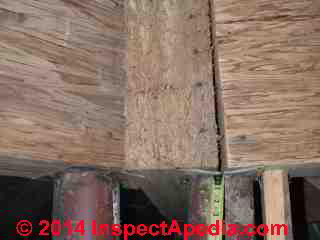 The crossed nails, when applied close together (as guided by the framing connector or by the hand of a competent framing carpenter), form a very strong forest-to-wood connection.
The crossed nails, when applied close together (as guided by the framing connector or by the hand of a competent framing carpenter), form a very strong forest-to-wood connection.
Use of toe-nailing, or angled opposed framing nails (Double-Shear in Simpson Strong-Tie's patented[10] joist hanger such as the particular adapted above), can permit the utilise of fewer total nails in a wood frame structure.
Our photo at left shows an unsuccessful use of toenailing in a failed attempt to connect intersecting glulam beams. The nails (those brown spots) pulled, bankrupt, bent, and allowed the connectedness to neglect.
The steel Lally columns are as well non properly located an installed.
These beams are non properly continued and their structure is in danger of plummet. That some movement has already occurred is evident in the gap above my tape measure.
The forcefulness of a toe-nailed wood framing connection will be affected by:
- How shut to opposite ane another the two nails are placed
- Using nails of sufficient length to fairly penetrate both woods members
- Nailing the toe-nails at the proper angle (45 degrees).
- Placing nails high enough from the edges of the abutting member (vertical in our sketch) equally to have adequate purchase and to avert merely splitting out a piddling scrap of the border of the 2x.
- Placing nails low plenty in that same member to be sure that the length of the smash penetrates both the abutting member and the nailed-to facing member.
- Using the correct number of nails specified for the lumber sizes involved.
- The species and class of the lumber being used and of course the condition of the lumber
- The type of loading: shear loading or lateral loading versus withdrawal loading that will be applied to the connexion
How Many Nails to Apply When Toe-Nailing
Because the "toe-nails" cantankerous ane some other in the header or ledger lath when used to secure a deck joist, this connection can actually be stronger than direct-in or stop-nailing the deck joists from the other side of the ledger or girder.
But using too many nails (below left) or also few nails (below right) is a mistake that results in a weak connectedness and potentially an unsafe construction.
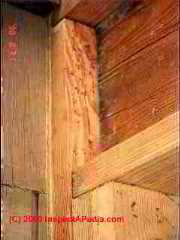
Using Likewise Many Nails when Nailing Wood Framing
Using too many nails in a framing lumber connection when toe-nailing or in whatsoever position for that thing will also cause a weak framing connectedness that tin atomic number 82 to structural collapse.
That'south because an excessive number of nails actually fractures the lumber. If you click-on and enlarge our photograph at to a higher place left you'll see that the contractor fractured the vertical stud well-nigh its height. Our photograph (left) shows nigh 30 nails shot by the builder during framing of this home.
The framer was trying to bulldoze a recalcitrant stud into position. Clamps might accept worked ameliorate.
This stud was and so split as to lose its structural integrity, and replacement of this wall stud was needed.
As we prove beneath, adding more nails, even with a pneumatic nail gun, does not exercise a great job of pulling together framing members that are separated.
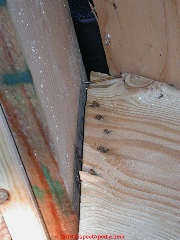
Too few nails when toenailing framing
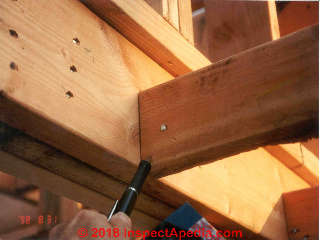
Using too few toe-nails in a framing lumber connection is going to make a weak construction that could plummet.
For lawmaking compliant nailing run across the blast schedules in the applicable building code for your area. For instance run into the UBC Tabular array 25-Q Nailing Schedule. A few examples are cited below.
- Studs: 2x4: 4 nails - In the bottom of a 2x4 stud we apply ii nails per side, contrary one another, crossing in the nailed-to member.
- Studs, 2x6: 6 nails - In the bottom of a 2x6 stud nosotros'd use 3 (and in some cases 4) nails per side.
- Joist to ledger board: varies past joist depth.
In a 2x6 joist I'd employ 8 nails, 4 per side.
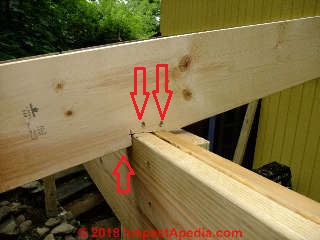
- Rafter toenail connections:
At the birds' rima oris cut of a rafter connecting to the top plate we use three nails per side, ii down through the height of the birds' mouth into the top plate and one (on either side) of the rafter'south vertical portion of the bird's mouth cut into the face of the peak plate.
Really? Well aye, in traditional woods framing we toe-blast the rafter to the top plate at the birds oral fissure cutout. However depending on the location of the structure and framing practices, the architect may use a framing anchor specifically designed for joining a rafter to the top plate of the wall.
Our photo higher up shows a bird'due south mouth notch in a porch rafter sitting atop the outer girder - equivalent in location and rafter measurements to setting a rafter atop the wall acme plate of a edifice wall.
In a properly-cutting bird's mouth, the length of the horizontal or level line (beneath my two red arrows in the photo above) should be virtually equal in length to the width of the summit plate.
The actual blueprint of the bird's oral fissure cut will vary in both length and depth co-ordinate to the width of the meridian plate, the angle of the roof, the design of the roof overhang and also the use of framing connectors.
Some framing anchors eliminate the birds mouth notch; a framing anchor provides a steel nailing plate connector that provides a stronger connexion with ameliorate hurricane or storm air current resistance. Similar special connectors are provided for connection of the rafter to the ridge.
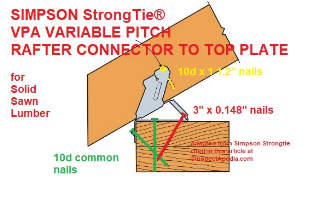
Above: a Simpson Strongtie® VPA variable pitch rafter-to-wall connector designed for solid sawn lumber. Detect that using the VPA rafter connector the bird's mouth cut or notch is eliminated. [Click to enlarge any epitome]
Beneath: a Simpson Strongtie® H1.81Z Hurricane Tie designed for LVL roof rafters to requite a stronger connection to the top plate
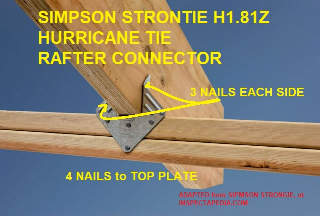
At the ridge the rafter is toe-nailed to the ridge board OR a steel framing connector can be used. Below my photo shows separation between the rafter face and the ridge board.

Beneath: questionable rafter-to-wall connections
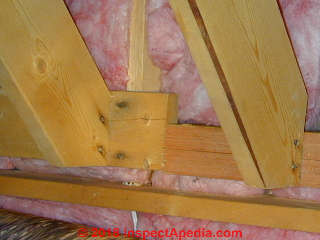
Above: two visible, possibly four maximum, toe-nails through rafter ends along with some other rather odd wood framing in a U.Southward. domicile inspected by the author.
In my Opinion (not an engineering opinion) and from what nosotros can see, these rafters are not adequately continued to the rest of the structure.
- Girder or beam to post, plate or other connections: must be specified past the design
Examples of Nailing Schedule for Toe-Nailed or Slant-Nailed Forest Framing Connections | |
| Woods Frame Connection Type | Number of Nails Required |
| Blocking or Bridging, betwixt joists / rafters | 3-8d into superlative plate ii-8d into joists at each terminate of the block or bridging |
| Ceiling joist to top plate of wall | three-8d toenails - 12d |
| Cross bridging between joists | ii-8d nails |
| Header to studs | iv-8d - 12d toenails ii on opposing sides |
| Rafter to surface of top plate | iii-8d - 10d - 12d toe-nails (see notes in text to a higher place), also 10d box nails may be used in some jurisdictions. |
| Flooring joists or ceiling joist to superlative surface of sill plate or girder summit | 3-8d common toenails, or 10d, or 12d |
| Floor joists or deck joists to ledger board face | iv-half dozen 8d or 10d toenails per side, 2x6 joist; number per side increases for deeper joists; |
| Joist & rafter blocking | three-8d, face nail from 2 nails from one side |
| Rim joist to surface of top plate or sill plate | 8d, 6" o.c. |
| Wall stud (2x4) to top plate | 2 - 16d finish-nails (through the plate from below, into the stud end) |
| Wall stud (2x4) to sole plate or "shoe" | 4 - 8-d toe-nails or 2 - 16d end-nails (through the plate from below, into the stud terminate) |
Notes to & Complete Nailing Schedule Sources for table higher up
- Boom FASTENING SCHEDULE - 2016 CALIFORNIA BUILDING Lawmaking Tabular array 2304.10.1 [PDF] Building & Safe Division, Plans & Permits Div., City of Fremont California, 39550 Freedom St., Fremont CA 94538, Website: www.fremont.gov, original source: https://www.fremont.gov/DocumentCenter/View/7140/FASTENING-SCHEDULE?bidId=
- NAILING SCHEDULE - 1994 Uniform Building Code Tabular array 23-I-Q [PDF] - this PDF provides the entire woods framing nailing table that serves equally a general guideline on number of toe-nails used and smash size used for various residential forest framing connections.
- RESIDENTIAL NAILING SCHEDULE TABLE R602.3(one) FASTENER SCHEDULE for STRUCTURAL MEMBERS [PDF] Dublin CA Building & Safety Division, 100 CIvic middle Plaza, DublinCA 95468 USA, Tel: 925-833-6620 website: dublin.ca.gov
- IRC Code: IRC–12/13 Tabular array R602.iii(ane) Fastening Schedule for Structural Members
Other code & data source citations for nailing schedules are given below
Watch out: Information technology is essential that nails be driven from both sides of the member for a proper toe-nailed connexion.
How to continue the framing member in position when toe-nailing
Framing tip : if y'all've marked the stud, rafter, or joist location on the nailed-to plate or ridge board you may find that as yous toe-nail the commencement nail into the side the nailed-through member begins to slide past the placement line.
If the movement of the nailed-through member off of the layout line is 1/8" or less, go alee and terminate the first nail, just then start the second nail on the opposite side of the nailed-through fellow member. As you finish that blast you volition bulldoze the nailed-through member back to its verbal position on the layout line.
If the motion off of the layout line is more than than 1/8", cease nailing the start toe-boom and starting time the second opposite-side toenail to motion the member dorsum into position.
Rather than tippy-tap dorsum and forth on the two sides, you lot should be able to fully drive the 2d nail even if it moves the fellow member back over the layout line upwards to 1/eight" in the contrary direction. When y'all terminate nailing the first toenail yous'll drive the member back into perfect position.
Then terminate the remaining toenails, taking turns to nail from opposing sides.
Where to Place the Nails When Toe-Nailing
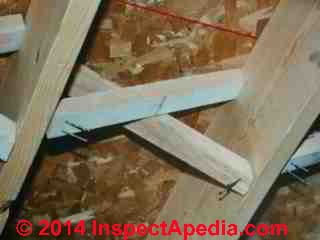 at left is an example of angle or slant nailing that is not "toe nailing" because the nails for each connection are being driven into merely i side of the mated wood members. That's ok for this awarding.
at left is an example of angle or slant nailing that is not "toe nailing" because the nails for each connection are being driven into merely i side of the mated wood members. That's ok for this awarding.
Incidentally, you may notice that the joist bridging shown at left was nailed at its upper cease before the subfloor was ready in identify. Simply no ane remembered to finish the task. The nails in the bridging ends testify proper placement and angle for nailing into the joist bottom edges.
Outset let's understand the objective: we want the toe-nailed nails to achieve the post-obit:
- Avoid splitting the nailed-through member: this means don't get-go the toenail to close to the very stop of the nailed-through member. Unremarkably 3/four" to 1 i/4" before the terminate of the nailed through member volition work.
- Obtain sufficient depth or bite into the nailed-to framing member. This means we want 3/4" or more than of smash fully into the body of the nailed-to fellow member. Cull a nail of the correct size (see below) and right location to achieve this.
If you're not sure about the angle (about 50° to 60° up from horizontal) or starting location of your nail from the end of the member, hold your toenail across an instance of the to-exist-continued lumber where the stop of the nailed-to member is visible. You lot'll be able to meet the depth to which it'southward going to penetrate.
Toenail or Slant-nailing Spacing Specifications | |
| Location | Minimum Clearance Distance |
| Minimum finish-altitude to start the toenail: | 7/8" |
| Minimum edge altitude to start the toenail | 7/8" |
| Minimum center-to-heart altitude for spacing toenails | 1 3/4" |
Notes to the table above
Some model edifice codes such as the UBC specify the spacing for camber nailed or toenailed connections, with differing requirements depending on whether the objective is to reduce shear loading or lateral loading versus withdrawal loading.
Building lawmaking specifications for nailing schedules also include assumptions about the wood species and grade, typically Douglas-fir/larch or Southern Pino lumber.
What size nails should exist used for toe-nailing
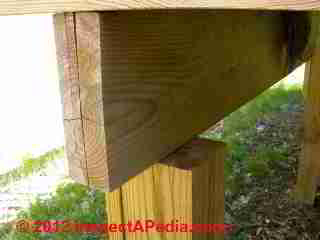 Our photograph (left) shows a congenital-upwards girder sitting atop a wood post with no visible connection.
Our photograph (left) shows a congenital-upwards girder sitting atop a wood post with no visible connection.
Merely in my OPINION the typical "toenailing" of this girder to the post top that some builders may use would nonetheless exist an inadequate connexion.
This connection, discussed in detail at FRAMING CONNECTORS & JOIST HANGERS, is an unsafe structure that risks collapse.
Reader question: (July 22, 2012) Ron said: three" or 3 ane/four" for toe nailing 2x lumber?
Answer: Ron,
In the article above yous tin meet an illustration of toe-nailing showing nails crossing into the nailed-to fellow member for strength.
- The required nail size for toenailing or slant-nailing depends on the application, location, blazon of connectedness, and size of lumber involved.
- The smash size also affects the number of nails required.
- For instance in connecting a wall stud to the sole plate we use 2 end-driven 16d nails OR 4 8d toenails.
- As another example, where making structural connections of larger lumber sizes using 16d (3 i/two") common nails, the Compatible Edifice Code (UBC) requires i 3/iv" of penetration into the nailed-to fellow member.
- For nailing typical 2x studs to a lesser plate or top plate the UBC requires four 8d common nails, two per side of the stud.
- A 3-inch smash or 10d blast would exist large enough for almost common framing situations. In fact some framing texts (Wagner, Willis H, "Modernistic Carpentry" (1976)) draw using four 8d toenails, nearly likely again out of a concern to avoid splitting bug.
Driven a properly-sized nail on a proper angle through the 1 i/2" of thickness of 2x lumber you've got 1- three/4" bite into the lumber beneath;
Toe nailing can be quite strong if properly installed - with nails in pairs set on opposing sides and at opposing angles so that they "cross" inside the nailed-to wood. Only if "toe nailing" is done only from i side the framing connection is non strong and in my opinion not proper.
It's too important to locate the toenail correctly - if it's too close to the bottom of the vertical stud or end of the horizontal framing joist it will split the wood and won't take enough bite in the nailed-through member.
If on the other mitt the toenail is also high in the nailed-through member it won't accept enough bite in the nailed-to member. I toenail about an inch from the end of the nailed-through fellow member and on an angle that I can visualize as sending a good portion of the smash into the body of the nailed-into member.
How to avert splitting when toenailing or camber-nailing forest framing
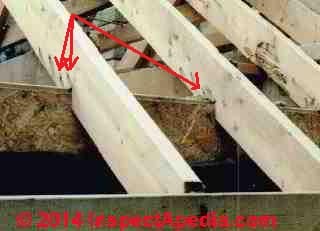 Kickoff by keeping the toenails a sufficient altitude from the finish of the nailed-through member just non and so high that you won't take adequate penetration into the nailed-to member.
Kickoff by keeping the toenails a sufficient altitude from the finish of the nailed-through member just non and so high that you won't take adequate penetration into the nailed-to member.
In our photo at left I point out the location of two of the four required toenails for nailing the rafter to the top plate at the birds' mouth cut.
I don't see any splitting just I'm worried that the nails may be a bit high. Depending on the size of smash used there may non exist acceptable penetration into the meridian plate.
Photo courtesy of Carson Dunlop Associates, a Toronto technology & dwelling house inspection business firm and habitation inspection education company.
Framing tip : experienced carpenters larn to place the long axis of the diamond-shaped cutting tip of a common framing nail beyond the wood grain of the nailed-into member.
This position minimizes splitting. Equally you lot take the boom out of your smash apron with your left manus, but place the tip of your third finger on the nail tip and employ your pollex and forefinger to roll the nail so that you experience its long axis against the flat of your third finger. With the nail in that position, as you start the fastener, place the long axis of the nail point beyond the forest grain.
A 3 1/two inch common smash or 16d might be over-sized for toe-nailing and is probable to split the 2x, especially if nailed most the edges of the lumber.
You originally asked this question in an article on framing connectors. Framing connectors, an alternative to toenailing, are nailed straight into the respective framing members using common, galvanized only curt framing connector nails, non total length common nails.
Separately, in our article on framing square utilize,
at FRAMING SQUARE for BIRDS MOUTH CUT
we explain how the bird'southward rima oris cut is located in a rafter by following the rafter's line length from ridge to outer face of wall top plate.
Toe-nailing & Slant-Nailing References
- Breyer,Donald E., Kenneth Fridley, Kelly Cobeen, David Pollock, Blueprint of Wood Structures - ASD, McGraw Hill, 2003, ISBN-10: 0071379320, ISBN-13: 978-0071379328
- Harris, Samuel Y. P.Eastward., AIA, Esq., Building Pathology, Deterioration, Diagnostics, and Intervention, ISBN 0-471-33172-4, John Wiley & Sons, 2001 [Full general building scientific discipline-DF] ISBN-10: 0471331724 ISBN-13: 978-0471331728
- Wagner, Willis H, Modernistic Carpentry, Building Construction Details in like shooting fish in a barrel-to-empathize grade, [at Amazon] The Goodheart-Wilcox Co., Inc., 1976, ISBN 0-87006-208-5
- Watt, David , Building Pathology: Principles and Practice, Wiley-Blackwell, second edition (March seven, 2008) ISBN-ten: 1405161035 ISBN-13: 978-1405161039
- 1994 Uniform Building Code Table 23-I-Q, Table 23-2-8-1, Tabular array 25Q
- "Residential Improver Submittal Checklist", Metropolis of Ripon, Public Works Section, excerpts from model building codes including the UBC nailing schedule, retrieved v/20.14, original source http://www.cityofripon.org/Building/PDF/09-Residental-Addition.pdf
- Wisconsin Administrative Code, Affiliate SPS 321, Construction Standards, retrieved 5/20/fourteen, original source: http://docs.legis.wisconsin.gov/lawmaking/admin_code/sps/prophylactic _and_buildings_and_environment/320_325/321.pdf
Reader Comments & Q&A
improper toe-nailing: likewise many nails, dissever lumber
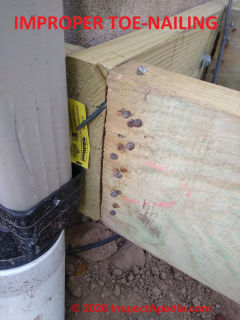 Matt: those joist connections don't look too dainty to me either.
Matt: those joist connections don't look too dainty to me either.
1. The nails are rather close to the joist end. At some of those locations the joist end is splitting, giving a weak and potentially unsafe structural connectedness.
2. The nails are mis-driven in at least one case (from the joist summit) - missing the ledger.
3. The ledger is carve up at the terminate from having driven what looks like 14 nails on that side of the outermost joist - and that'southward before fifty-fifty looking at the other side of the aforementioned joist where more nails may be nowadays.
In a 2x6 joist I'd use a total of 8 8d or 10d nails, 4 per side, typically 8d in size or in some cases 10d - these are the almost-usually-used nail sizes when toe-nailing 2x framing lumber as unless you're using box nails, larger nails tend to split the lumber, specially when, as in your photograph, they're nailed likewise shut to the finish of the joist.
4. The next ledger (near the photo's upper right corner) in is roughly cut, not flush with the ledger board, nailed too close to the joist stop and perhaps also sports also many nails. Besides many nails actually weaken the connection by splitting the forest especially at the joist end.
5. In the ledger board connection to the structure, there is an exposed nut and washer that expect loose merely I can't see enough to be sure how this framing member is secured to the building;
you certain want that ledger board to be properly and securely connected to the building (at what looks like a physical block or parged foundation wall)
6. I see no flashing between ledger and building
Watch out: inadequately or poorly fastened framing risks structural collapse and injury
Luckily all is non lost. The careful add-on of properly-sized steel joist hangers MIGHT be able to salvage this situation; the down-side is having to drive once more more nails into the joist but the hangers can be nailed to the ledger board and those fasteners volition be farther away from the indicate at which the joist butts into the ledger board.
When I've run across this state of affairs and the lumber was badly carve up the contractor agreed to replace it and re-frame the area.
When I've had to use steel joist hangers or mending plates in these situations I accept great care to use the proper fastener; joist hanger nails or screws are manufacturered inthe proper size, both diameter and length, for use with these structural fasteners.
Watch out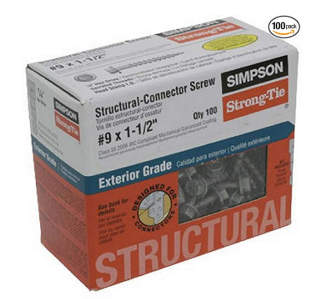
An example of that production is shown above, Simpson Strong-Tie Structural Screws SD9112R100 No.9 past i-1/2-Inch Structural-Connector Screw - specifically designed for this application.
The company says: Simpson Strong Tie SD Structural-Connector Screws are designed to be used with Simpson Connectors for both interior and exterior applications.
Frankly I can't meet much from ane photograph but I concord that some additional measures are appropriate.
I've had a contractor building a deck. They put the initial joist(2x8 treated) too far apart and concluded up using a reciprocating saw to cut the nails where they went to the ledger.
When they nailed them back in, it appears they did not employ galvanized fasteners. The contractor fired the coiffure, and the new crew is now using joist hangers with the same joist to adhere information technology to the ledger.
I'one thousand worried that the joists are nailed out now and new joists should be installed, but the contractor is fugitive information technology due to the big cost.
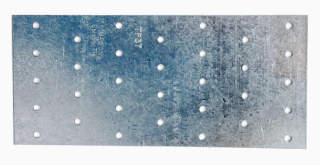 Chuck:
Chuck:
If the split your photos show is in a rim joist that sits atop a foundation wall or sill then it's not likely to presage a sag or collapse;
and I'm unclear how you could run lag bolts up through the bottom of the joist as information technology'southward bottom is atop a foundation or sill.
You could, withal, add steel mending plates to reinforce the area of the carve up.
Shown hither is a Simpson TP37 flat metal mending plate from Simpson Strong Necktie
I have a daylight rambler with post & beam down the length of the house in the basement.
For most of the length, joists sit on summit of the beam, but for about 11 feet at one cease the joists are toenailed into the beam and sit on a 2x4 sill nailed forth the bottom of the beam, which provides better headroom for that area.
I decided to tie every other opposing joist together through the beam in social club to better resist them coming apart in an earthquake.
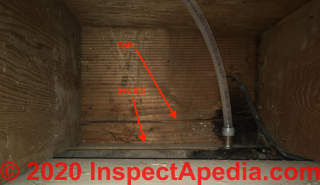
Yet, when I started looking at the "hidden" (by pipes & ductwork) side of the beam, I establish a separate running for around eight anxiety about 3-four" above the sill.
I'yard wondering if that'southward a trouble and, if so, whether running lag bolts upward through the beam to reinforce it would assistance. Offset photo shows the construction. Second photograph shows the scissure on the opposite side of the beam.
This is the second photograph meant to go with the previous post.
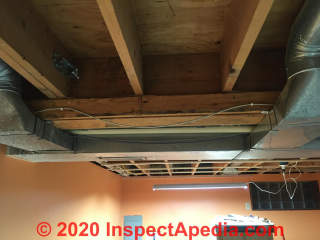
Jan
As long as the nails are the right size for the framing members and the right number are used, toe-nailing is perfectly adequate. It does crave a bit more expert workmanship to go the connections neat, proper, and potent, but, then, a careless worker can foul up joist hangers just as easily.
Building a floating deck. Contractor wants to use toe nailing instead of joist hangers. What are your thought
John
In the article above we give the recommended number of toe-nails per side for various dimensions of 2x lumber. That's what I recommend every bit your guide.
There is no single exactly right answer to your question because wood is a natural fabric from a living establish that is not absolutely consequent and identical by species nor even from one lath or 2x to the next of the same species, fifty-fifty the aforementioned tree.
In a given 2x for example, wet content, forest species, the presence of a knot, the proximity to heartwood, the presence of existing damage or splits, variations in grain density and direction, as well as the blast bore and fifty-fifty nail cross department shape and the angle to which the nail is driven and the closeness of the nail entry point to the end of the member ALL bear on the probability that the member will separate effectually the boom, weakening or ruining the connectedness.
Cheers for asking a great question. We volition go on this with the article and add together other factors in the probability that a piece of forest is going to split or otherwise have a poor nailed connection.
How much of a gap can there exist between toe-nailed members before the toe-nails kickoff losing effectiveness??
JoAnn the nailing schedule, size, number are given for toe nailing in the article higher up.
Your local building department and your codes could require other connectors, depending on where you live, such as for seismic or high wind conditions.
What I take read hither sounds to encompass my business concern somewhat on toe nailing beam to joist. I will ask though, for my personal use: This involves constructing a patio embrace. In connecting a double 2x6 beam to a 2x6 joist, and if toe nailing, what recommendation in club to pass city code, tin can be given me on proper nailing to use, boom size, how many and how placed. The rafters/joist will be over the double 2x6. Thank you.
Can 4x4 Posts be toenailed with four in screws on decking to hold roof
...
Proceed reading at FRAMING FASTENERS, NAILS, SCREWS or select a topic from the closely-related articles below, or meet the complete Article INDEX.
Or see these
Recommended Articles
- CONNECTORS, FASTENERS, TIES
- FRAMING CONNECTORS & JOIST HANGERS
- FRAMING Foursquare for BIRDS MOUTH CUT
- HURRICANE Tie Downward CONNECTORS & FASTENERS
- STAIR STRINGER to FRAMING CONNECTORS
Suggested citation for this web page
TOE NAILED FRAMING CONNECTIONS at AuditApedia.com - online encyclopedia of building & environmental inspection, testing, diagnosis, repair, & problem prevention communication.
Or encounter this
Index to RELATED ARTICLES: ARTICLE Index to BUILDING DECKS & PORCHES
Or employ the SEARCH BOX found below to Enquire a Question or Search InspectApedia
Or encounter
Alphabetize to RELATED Manufactures: Commodity Index to BUILDING STRUCTURES
Or apply the SEARCH BOX plant below to Ask a Question or Search InspectApedia
...
Ask a Question or Search InspectApedia
Attempt the search box merely below, or if you prefer, post a question or comment in the Comments box below and we volition respond promptly.
Search the InspectApedia website
Note: appearance of your Comment below may be delayed: if your annotate contains an image, web link, or text that looks to the software every bit if information technology might be a spider web link, your posting will appear after it has been canonical by a moderator. Apologies for the delay.
Technical Reviewers & References
Click to Show or Hide Citations & References
Publisher InspectApedia.com - Daniel Friedman
Source: https://inspectapedia.com/structure/Framing_Toe_Nailing.php
0 Response to "What size and type nail would you use to nail an LVL together with?"
إرسال تعليق